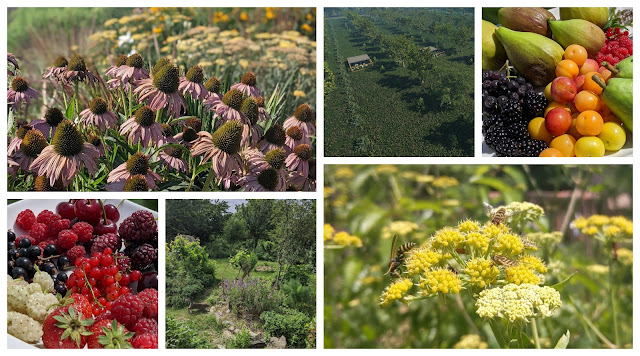We have started a new section on the blog profiling polycultures that we are growing in our gardens or are intending to plant in our gardens in the near future.
This post provides a description of the profile layout and some general notes to consider if you would like to try and grow the polycultures that we introduce.
The polyculture plans we present are offered as a starting position as opposed to a finished article. How a polyculture performs will vary considerably from site to site due to climatic/microclimatic and edaphic factors, the plant material used, and your own establishment and management practices.
Each polyculture is presented as follows
But first, just to let you know about our Online Store where you can find Forest Garden/ Permaculture plants, seeds, bulbs, and Polyculture multi-packs along with digital goods and services such as Online Courses, Webinars and eBooks. We hope you enjoy the store and find something you like :) It's your purchases that keep our Project going. You can also find our full list of trees. shrubs and herbs for forest gardens on our website here
The Profile Layout
Polyculture Name - The working name for the polyculture and the polyculture category i.e Productive - Support or Infrastructure.
Intro - An overview stating the primary purpose of the polyculture and a brief description of the key features
Compatible Climate(KCC) - Indicates the climate zones that are suitable for growing the polyculture. Based on the Köppen Climate Classification system to indicate the climatic compatibility. In areas at higher latitudes be aware that your light levels will be lower so your canopy density should be thinner. i.e wider spacing, fewer plants. Microclimatic conditions should be well considered when assessing the compatibility of the polyculture for a site. You can find a KCC google earth overlay map here.
USDA Hardiness - Indicates the hardiness zone that the polyculture can be grown in. I have used the hardiness of the least hardy plant in the polyculture for the lower limit and often this is just one plant. For growers in colder areas, this plant (or plants) can be replaced with a hardier species that more or less match the role the plant serves so do not rule out trying a polyculture based on this information alone. You can find the individual hardiness of each plant in the species list table further on in the profile. more on plant hardiness here.
Water Needs - Indicates the general water/irrigation requirements of the polyculture
Light Preferences - Indicates the general light preferences of the polyculture
Soil Preferences - Indicates the preferred soil conditions of the polyculture. The plant combinations and spacing I am using are generally based on working in soil that is in optimal or near-optimal condition to start with as we always prepare poorer soils in advance of planting. On soils that are in moderately good condition. I’m confident these planting schemes will work.
Suitable pH - Indicates the preferred soil pH of the polyculture. All of the polycultures we grow are on soils with a pH in the range of 5.0 - 8.5
Layout - Suggests possible layout options for the polyculture based on the Spatial Layout options

Overview Image - An illustration of the design. This image often depicts the polyculture in the early stages of development and will include the broad dimensions of the design area and labeled positions of the species and features
Functional Components - Summarizes the potential functionality of the polyculture in the following areas:
- Production Potential - Summary of production potential
- Fertility Potential - Summary of fertility potential
- Habitat Potential - Summary of habitat potential
Access - Describes the access within the polyculture
Species List - A table listing all of the plant species used within the polyculture, and how many of each species are required (per unit depicted), the botanic and common name, the family, USDA hardiness zone, forest garden layer, and function
Maturation Phases - An illustration of the polyculture design when initially planted and when mature. Sometimes other intervals of the growth development stages are included here
Planting - A diagram of the planting layout indicating distances between plants and planting location within the planting zone. For some polycultures, you will also find suggestions for layout variations in this section
Flower/Fruit and Maintenance Table - This table shows the flowering and fruiting times for each of the species included in the polyculture and specific maintenance tasks for each species. It also contains a section providing information on the general maintenance tasks required for the polyculture in the following categories
- Trim and Prune - When and what to trim and prune
- Irrigation - When to irrigate
- Access - When and how to maintain access
- Mulch - When and what to mulch
A word on the flowering and fruiting times on the calenders. During long cold winters in locations at high altitudes or regions of high latitudes, plants will not follow the sequence as indicated on our calendars. In our gardens at approx. 580 m above sea level on the 42nd parallel north, the calendars are an accurate representation, although there is a lot of variation within the month each year.
All establishment and maintenance information provided is based on using starter plant material i.e, rhizomes and cuttings and 1st or 2nd-year-old saplings. If you are using mature plants or older plants you need to account for differences i.e, fewer plants may be needed, more irrigation and fertility provided to support older/larger plants, and possibly staking and supports if very large plants are used. I always recommend using starter material as it will very often outperform larger plants in the long run, requires less input and attention to establish, and is significantly more cost-effective especially when planting at scale.
Aside from the essential maintenance for some of the amenity plantings and more ornamental polycultures, the level of maintenance required will always depend on the level of tidiness preferred. Generally speaking the less tidy you are the more attractive to wildlife your polycultures will be but there is merit in keeping some areas tidy, namely providing plenty of space for air circulation, allowing more even light distribution within the plant layers, and checking plants that may dominate an area thereby reducing biodiversity. It is much easier for the majority of people to connect with a garden that shows at least some order. Having beautiful, as well as productive and biodiversity-enhancing polycultures, is an important factor when recruiting and inspiring new growers.
Regenerative Landscape Design - Online Interactive Course
Want to learn how to design, build and manage regenerative landscapes? Join us on our Regenerative Landscape Design - Online Interactive Course. We look forward to providing you with the confidence, inspiration, and opportunity to design, build and manage regenerative landscapes, gardens, and farms that produce food and other resources for humans while enhancing biodiversity.
You can find the course details here and at the moment we have a $350 ( 20%) discount for full enrollment to the course. Just use RLD2024 in the promo code section of the registration form to receive your discount.
You can find the first two Polyculture Profiles in the links below. We'll be adding more to this page from time to time.
Polyculture Profiles - Perennial Productive Polyculture- Asparagus, Garlic Chive, Strawberry - Plutus
Polyculture Profiles - Perennial Infrastructure Polyculture - Edible Hedge/Windbreak/Biomass - Terminus
Polyculture Profiles - Perennial - Productive - Production/Support - Hestia
Want to learn more about Regenerative Landscape Design? Join The Bloom Room!
The Bloom Room is designed to create a space for more in-depth learning, for sharing projects and ideas, for seeking advice and discovering opportunities.
Ultimately, it aims to build a more intimate, interactive, and actionable relationship between members, a way for the Bloom Room community to support each other’s projects and learning journeys, and to encourage and facilitate the design, build, and management of more regenerative landscapes across our planet.
What you can expect as a member of the Bloom Room
As a member of the Bloom Room you can expect;
Access to an interactive forum where you can ask questions, direct what type of content you would like to see as well as share your own content and projects.
Monthly live session featuring general Q&A and tutorials on design software for creating and presenting polycultures.
Live session every month for members to showcase your projects, plans, designs, and gardens, with guest speakers from the community.
Full Access to all of the content on Substack
A 50% discounts on all of our online courses
Future opportunities to join our Global Regenerative Landscape Design and Consultancy Service, with potential roles for those with the will and skill to join our design team.
An opportunity to take part in the group ownership of a Regenerative Landscape. You will find more details on that here.
Become a paid subscriber to our Substack to join. The annual subscription is currently $70 and the monthly subscription is $7 (monthly subscription excludes discounts for products and services) . You can join here, we look forward to meeting you!
Support Our Project
If you appreciate the work we are doing you can show your support in several ways.
Become a member of the Bloom Room. A $70 annual or $7 per month subscription to our Substack provides you with access to live sessions, design tutorials, a members forum and more, see details here.
Make a purchase of plants or seeds from our Nursery or Online Store
Joining us for one of our Practical Courses or Online Courses
Comment, like, and share our content on social media.
If you appreciate the work we are doing you can show your support in several ways.
Become a member of the Bloom Room. A $70 annual or $7 per month subscription to our Substack provides you with access to live sessions, design tutorials, a members forum and more, see details here.
Make a purchase of plants or seeds from our Nursery or Online Store
Joining us for one of our Practical Courses or Online Courses
Comment, like, and share our content on social media.




.jpg)
.jpg)









